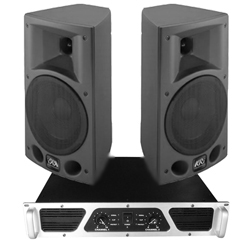
SMALLER AND LOUDER
Quick quiz: Which loudspeaker will play louder, one rated at 99 dB/1w/1M sensitivity and handles 500 watts, or one rated at 94 dB/1W/1M sensitivity and handles 1000 watts? Actually, the 99 dB/500-W driver will play louder and use less power to do it.
With a 300-degree (Fahrenheit) rise in temperature that can occur in high output applications, the voice coil’s DC resistance can rise from a typical 5.5 ohms to 10 ohms, and power delivered to the loudspeaker cut almost in half. Thus the 100-watt-rated loudspeaker in reality becomes a 500-watt loudspeaker when power compression is taken into account.
Power handing ratings? With the two-hour AES rating, which is most commonly used, the loudspeaker only has to survive for the duration of the test. Not a word about what it is doing, how it sounds, or the fact that it catches fire 2 minutes beyond the 2-hr. AES test duration.
What about the maximum sound pressure level (SPL) rating for the 1000-watt-rated loudspeaker? Using the usual 1-watt at 1-meter rating, we find that it will deliver 108 dB at about 330 feet without accounting for power compression. This leads us to a new specification: ILS, as in “If Lighting Strikes,” as in “If Lightning Strikes this SPL might actually be attained shortly before the loudspeaker disintegrates into a mushroom cloud.”
Where’s the amplifier in this scenario? Chances are that it’s at the end of at least 100 feet of 12-gauge copper wire. At the typical 1.7 ohms (resistance) per 1000 feet, this means a 1000-watt amplifier is really only delivering 959 watts at 8 ohms, 922 watts at 4 ohms, or just 855 watts at 2 ohms to the loudspeaker(s) (100 X 2 up and back = 200 ft. or 0.34 ohms).
Loudspeakers also depend on low source impedance to deliver a decently musical frequency response, including that “tight low end” which is the result of a high damping factor. Therefore the goal is a smaller cable impedance, not more wattage for good bass response.
What we really need to care about: desired sound pressure levels – BUT – with wide frequency response and low perceived distortion. The most important thing is to keep in mind what is REAL and what does WORK.
SPECIFIC ANSWERS?
Your ears work better than you know, and there are measurements that correlate much better to your ears than much of the stuff that currently fills specification sheets.
Further, it is possible to construct a test waveform more closely resembling music, and it is possible to weight distortion measurements so that they more closely correlate to how our ears perceive distortion. In light of this, aspects such as clipping characteristics and thermal capacity matter a lot.
It’s strictly my opinion, but this discussion leads me to conclude that many of the specific answers of the amplifier-loudspeaker equation might better be left to loudspeaker designers. They’re the ones who know how hard their loudspeakers can be pushed, and where, and without obscene noises and vaporizing voice coils.
This is why we’ve seen the emergence of more powered loudspeakers, which lends itself to a more “in tune” correlation of the two elements. Power matched to the specific needs of each component is a real benefit, while a crossover point tailored for the loudspeaker can better optimize the performance of individual drivers, individually and together. And so on…
Only with the willing consent of the loudspeaker will power drive the merger of the two elements to a stirring conclusion.
Brian Oppegaard is president of SpeakerPower Inc.
